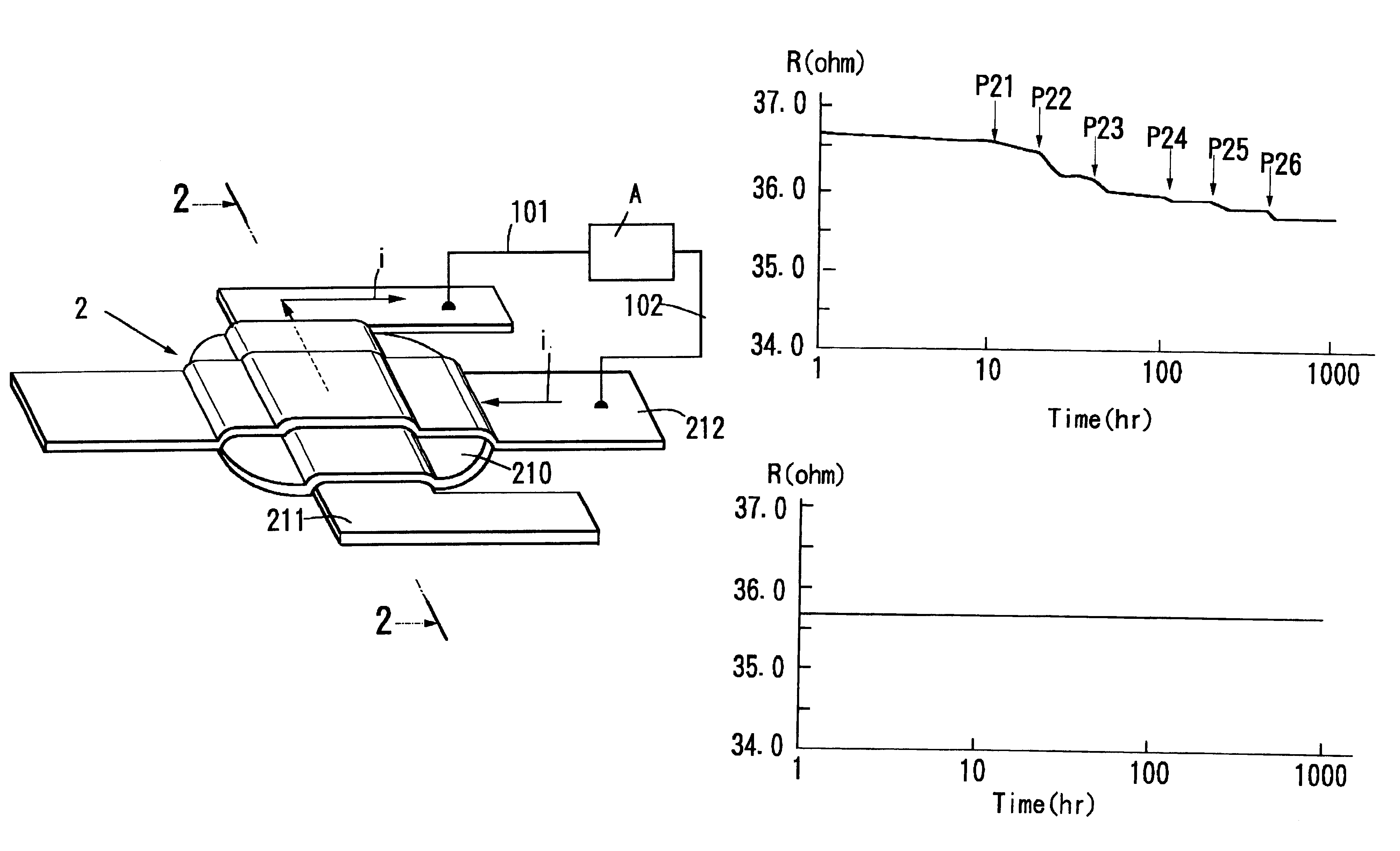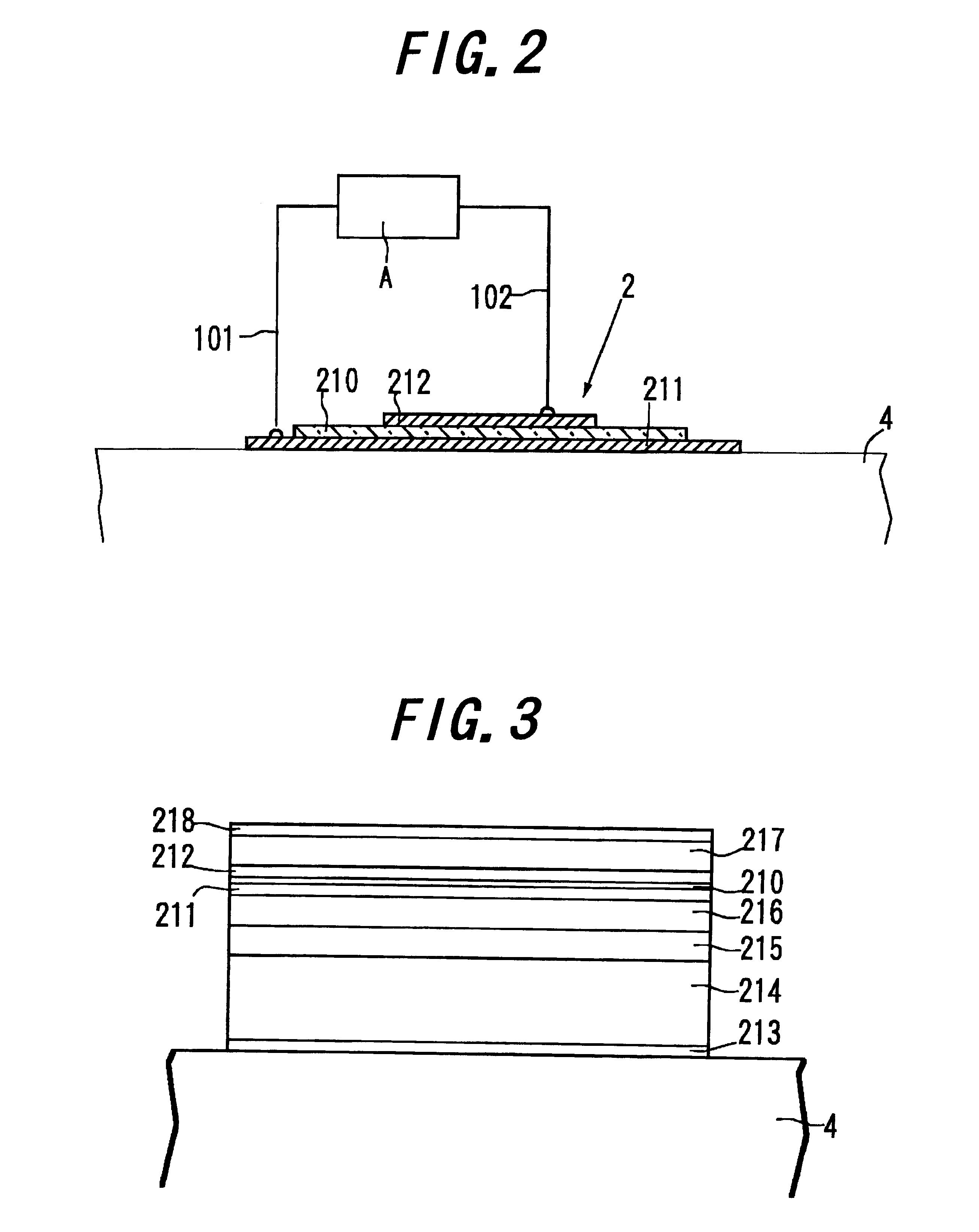Method for stabilizing properties of a ferromagnetic tunnel junction element
a technology properties, which is applied in the direction of electrical transducers, record information storage, instruments, etc., can solve the problems of acceleration of stabilization, deformation of reproducing output, and decrease of resistance of ferromagnetic tunnel junction elements
- Summary
- Abstract
- Description
- Claims
- Application Information
AI Technical Summary
Benefits of technology
Problems solved by technology
Method used
Image
Examples
example 1
The TMR element having the film structure in FIG. 3 was turned on electricity by a current with 7 mA larger than the above current with 1 mA, which is supposed to be applied in its practical operation, for 1000 hours at 70.degree. C. as its practical operation temperature. In this case, such a wire connection as in FIGS. 1 and 2 was employed.
FIG. 5A shows the obtained experimental data. The axis of abscissas and the axis of ordinate have the same scale as in FIG. 4. As shown in FIG. 5A, three soft break-downs P21 to P23 occur during the turning on electricity for 10-100 hours, and three soft break-down P24 to P26 occur during the turning on electricity for 100-1000 hours. The resistance R has a constant value of about 35.7 (ohm) at the turning on electricity of more than 1000 hours.
FIG. 5B shows the experimental data of the stabilized TMR element in FIG. 5A when a current with 1 mA, which is supposed to be flown during practical operation, is supplied. The axis of abscissas and the ...
example 2
The TMR element having the film structure in FIG. 3 was turned on electricity by a current with 7 mA larger than the above current with 1 mA for 50 hours at 70.degree. C. In this case, such a wire connection as in FIGS. 1 and 2 was employed.
FIG. 6A shows the obtained experimental data. As shown in FIG. 6A, three soft break-downs P31 to P33 occur during the turning on electricity for 10-50 hours.
FIG. 6B shows the experimental data of the stabilized TMR element in FIG. 6A when a current with 1 mA, which is supposed to be flown during practical operation, is supplied. As shown in FIG. 6B, a soft break down occurs in the stabilized TMR element after the turning on electricity for about 1000 hours by the current with 1 mA. That is, in this example, the stabilization for the TMR element is not sufficient.
example 3
The TMR element having the film structure in FIG. 3 was turned on electricity by a current with 15 mA larger than the above current with 1 mA for 24 hours at 70.degree. C. In this case, such a wire connection as in FIGS. 1 and 2 was employed.
FIG. 7A shows the obtained experimental data. As shown in FIG. 7A, several soft break-downs occur during the turning on electricity for 24 hours.
FIG. 7B shows the experimental data of the stabilized TMR element in FIG. 7A when a current with 1 mA is supplied. As shown in FIG. 7B, a soft break down does not occur in the stabilized TMR element after the turning on electricity for about 10000 hours by the current with 0.2 mA. This means that larger stabilizing current can shorten the stabilizing time.
PUM
| Property | Measurement | Unit |
|---|---|---|
| Angle | aaaaa | aaaaa |
| Angle | aaaaa | aaaaa |
| Electric potential / voltage | aaaaa | aaaaa |
Abstract
Description
Claims
Application Information
 Login to View More
Login to View More - R&D
- Intellectual Property
- Life Sciences
- Materials
- Tech Scout
- Unparalleled Data Quality
- Higher Quality Content
- 60% Fewer Hallucinations
Browse by: Latest US Patents, China's latest patents, Technical Efficacy Thesaurus, Application Domain, Technology Topic, Popular Technical Reports.
© 2025 PatSnap. All rights reserved.Legal|Privacy policy|Modern Slavery Act Transparency Statement|Sitemap|About US| Contact US: help@patsnap.com



